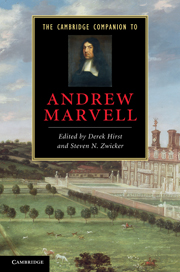Book contents
- Frontmatter
- 1 Introduction
- 2 The social modes of Marvell’s poetry
- 3 Marvell and the literary past
- 4 Borders and transitions in Marvell’s poetry
- 5 Thinking of gender
- 6 Marvell and the designs of art
- 7 Andrew Marvell’s citizenship
- 8 The green Marvell
- 9 A Cromwellian centre?
- 10 The poet’s religion
- 11 Adversarial Marvell
- 12 How to make a biography of Andrew Marvell
- Index
- Cambridge Companions to. . .
5 - Thinking of gender
Published online by Cambridge University Press: 28 March 2011
- Frontmatter
- 1 Introduction
- 2 The social modes of Marvell’s poetry
- 3 Marvell and the literary past
- 4 Borders and transitions in Marvell’s poetry
- 5 Thinking of gender
- 6 Marvell and the designs of art
- 7 Andrew Marvell’s citizenship
- 8 The green Marvell
- 9 A Cromwellian centre?
- 10 The poet’s religion
- 11 Adversarial Marvell
- 12 How to make a biography of Andrew Marvell
- Index
- Cambridge Companions to. . .
Summary
The twin issues of Marvell’s representation of gender and Marvellian sexuality are at their most visible in the bodies of the nuns of Appleton and their desires. Exceptionally, Upon Appleton House, To My Lord Fairfax inaugurates its bid to establish the supremacy of the contemplative paterfamilias across the defeated bodies of nuns, whose portrayal includes a subtle but unmistakable representation of lesbian desire:
Each night among us to your side
Appoint a fresh and virgin bride;
Whom if Our Lord at midnight find,
Yet neither should be left behind.
Where you may lie as chaste in bed,
As pearls together billeted.
All night embracing arm in arm,
Like crystal pure with cotton warm.
(lines 185–92)The question is whether the text will really allow itself to consider those desires as legitimate, or whether it rather inoculates itself against those longings by rendering them seductive. In this, it is Milton who is Marvell’s stylistic master, risking moral confusion by allotting the best tunes to the devil, and, as with Milton, this has led to some misreadings. The Fairfax family’s acquisition of former monastic lands was typical of families of their class; they were occupying lands formerly used by a convent, now ‘ruin[ed]’, and their conversion of them to a right use, the uses of family and heterosexuality, is about resisting the sensuous allures of overtly feminized missteps and building a new and properly reproductive nation.
- Type
- Chapter
- Information
- The Cambridge Companion to Andrew Marvell , pp. 68 - 86Publisher: Cambridge University PressPrint publication year: 2010
- 1
- Cited by

